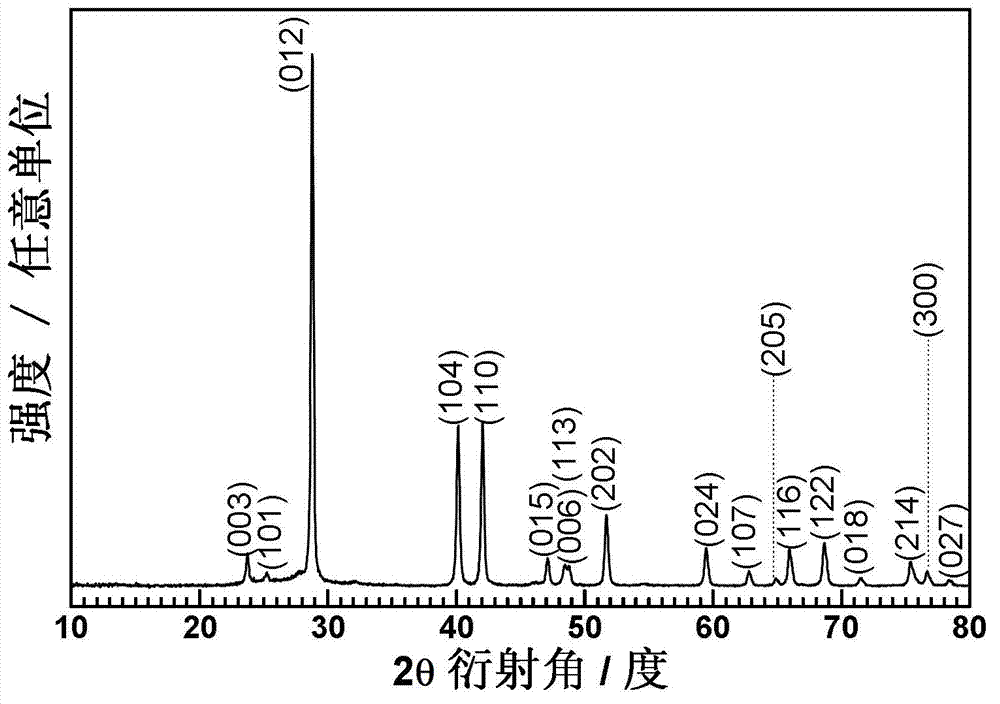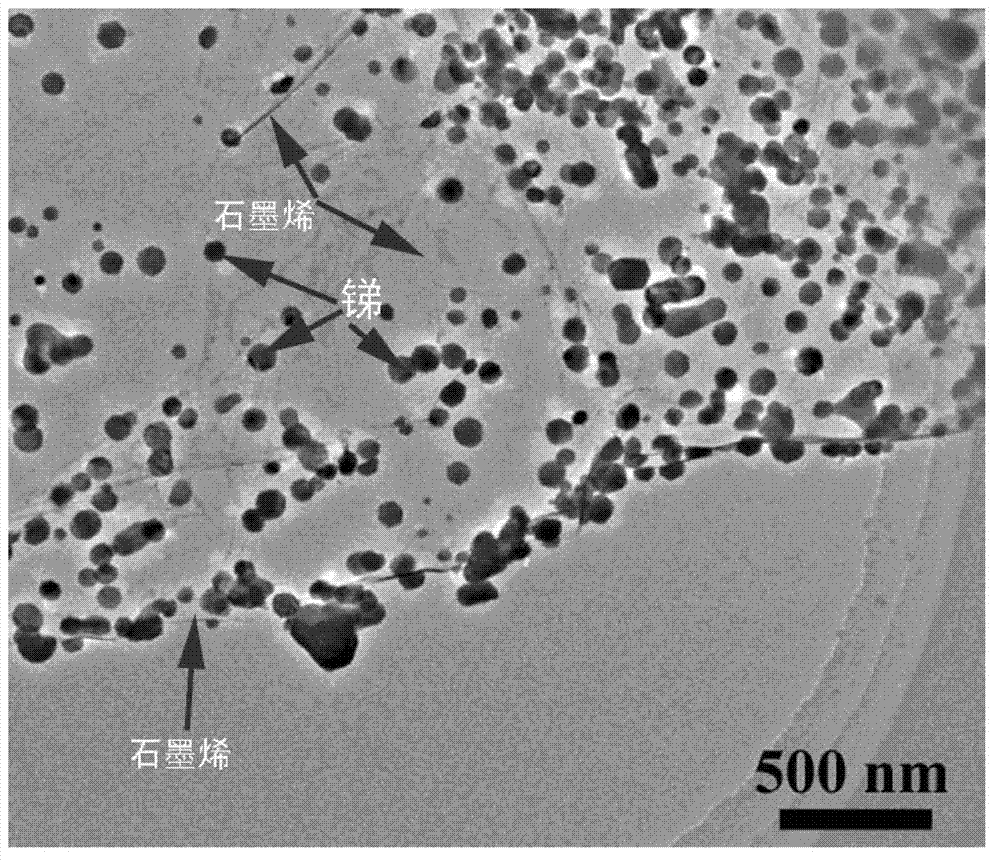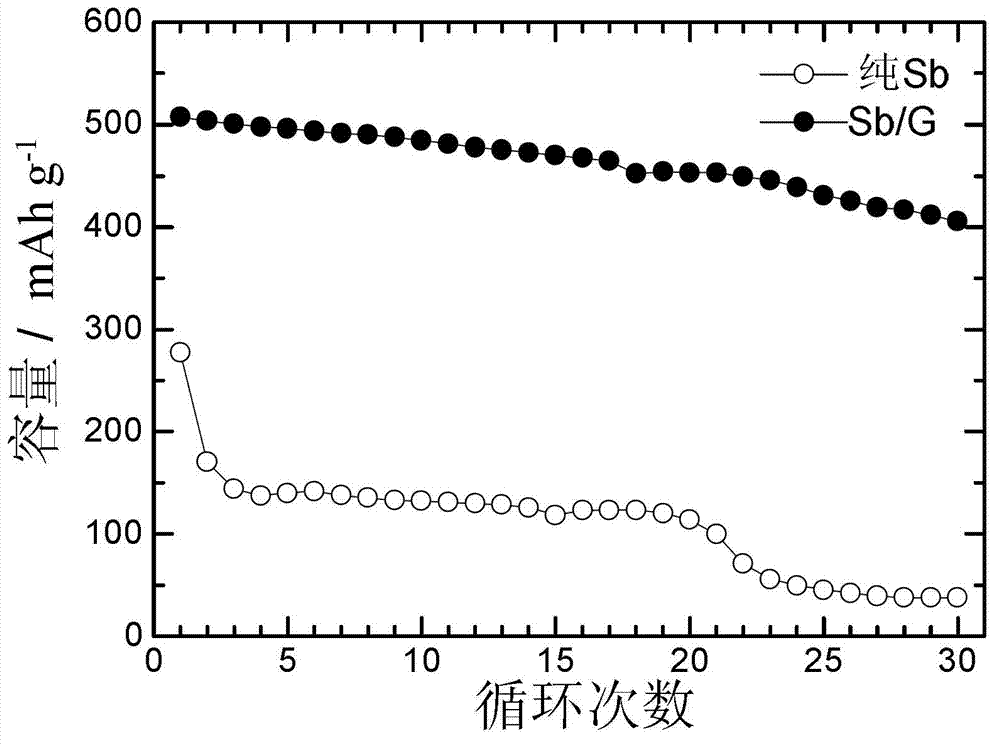Metallic antimony/graphene composite material, and preparation method and application thereof
A composite material, metal antimony technology, applied in electrical components, battery electrodes, circuits, etc., can solve the problems of poor electrochemical stability of metal antimony, large size of metal antimony particles, uneven distribution, etc. simple craftsmanship
- Summary
- Abstract
- Description
- Claims
- Application Information
AI Technical Summary
Problems solved by technology
Method used
Image
Examples
Embodiment 1
[0031] 1) The analytically pure SbCl 3 Dissolved in absolute ethanol to obtain Sb 3+ For a solution with a concentration of 0.2 mol / L, the volume of the solution is 80 milliliters.
[0032] 2) After adding 400 mg of GO to the solution in step 1), place it in an autoclave with a capacity of 100 ml (filling degree 80%, volume percentage), and add 6.8 grams of reducing agent NaBH to the solution 4 , then seal immediately.
[0033] 3) Heating the reactor to 200°C and reacting for 24 hours.
[0034] 4) Naturally cool to room temperature after the reaction, collect the powdery reaction product at the bottom of the kettle, wash it with deionized water and absolute ethanol alternately and repeatedly for several times, then vacuum dry the powder at 110°C for 12 hours to obtain a composite material powder , the weight percentage of graphene in the composite material is 8%.
[0035] The X-ray diffraction spectrum and transmission electron microscope photograph of the composite materi...
Embodiment 2
[0038] 1) Analytical pure Sb(NO 3 ) 3 Dissolved in deionized water to obtain Sb 3+Concentration is the solution of 0.05mol / L, and the solution volume is 80 milliliters.
[0039] 2) After adding 195 mg of GO to the solution in step 1), place it in a high-pressure reactor with a capacity of 100 ml (filling degree 80%, volume percentage), and add 6.2 grams of reducing agent KBH to the solution 4 , then seal immediately.
[0040] 3) Heating the reactor to 180°C and reacting for 36 hours.
[0041] 4) Naturally cool to room temperature after the reaction, collect the powdery reaction product at the bottom of the kettle, wash it with deionized water and absolute ethanol alternately and repeatedly for several times, then vacuum dry the powder at 110°C for 12 hours to obtain a composite material powder , the weight percentage of graphene in the composite material is 16%.
[0042] The composite material powder of gained is analyzed through X-ray diffraction spectrum and transmissio...
Embodiment 3
[0045] 1) The analytically pure SbCl 3 Dissolved in anhydrous ethylene glycol to obtain Sb 3+ Concentration is the solution of 0.3mol / L, and solution volume is 80 milliliters.
[0046] 2) After adding 290 mg of GO to the solution in step 1), place it in an autoclave with a capacity of 100 ml (filling degree 80%, volume percentage), and add 13.8 g of reducing agent KBH to the solution 4 , then seal immediately.
[0047] 3) Heating the reactor to 220°C and reacting for 48 hours.
[0048] 4) Naturally cool to room temperature after the reaction, collect the powdery reaction product at the bottom of the kettle, wash it with deionized water and absolute ethanol alternately and repeatedly for several times, then vacuum dry the powder at 110°C for 12 hours to obtain a composite material powder , the weight percent of graphene in the composite is 4%.
[0049] The composite material powder of gained is analyzed through X-ray diffraction spectrum and transmission electron microscope...
PUM
| Property | Measurement | Unit |
|---|---|---|
| diameter | aaaaa | aaaaa |
| thickness | aaaaa | aaaaa |
| particle diameter | aaaaa | aaaaa |
Abstract
Description
Claims
Application Information
 Login to View More
Login to View More - R&D
- Intellectual Property
- Life Sciences
- Materials
- Tech Scout
- Unparalleled Data Quality
- Higher Quality Content
- 60% Fewer Hallucinations
Browse by: Latest US Patents, China's latest patents, Technical Efficacy Thesaurus, Application Domain, Technology Topic, Popular Technical Reports.
© 2025 PatSnap. All rights reserved.Legal|Privacy policy|Modern Slavery Act Transparency Statement|Sitemap|About US| Contact US: help@patsnap.com



